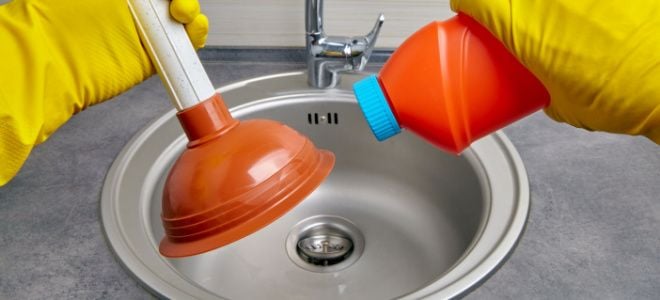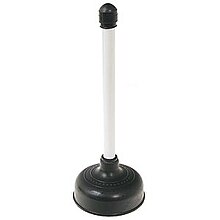This great article on the next paragraphs pertaining to How to Unclog Your Sink with a Plunger is extremely motivating. Don't bypass it.

Introduction
Appropriate upkeep of house drains pipes is necessary for preventing blockages and guaranteeing smooth water circulation. One of the key devices in every homeowner's toolkit is the bettor, along with numerous drain cleaners created to tackle stubborn clogs successfully. This article discovers how to utilize bettors and drainpipe cleansers effectively to maintain your drains pipes flowing openly.
Section 1: Comprehending Bettors
Sorts of Plungers
There are several types of plungers available, each designed for different sorts of drains pipes and blocks. One of the most typical types include cup bettors, flange bettors, and accordion bettors.
How Plungers Job
Bettors work on the principle of producing stress and suction to remove blockages. When effectively used over a drain, they produce a vacuum cleaner that can pull out debris or break up blockages.
Selecting the Right Plunger
Choosing the ideal bettor relies on the sort of drain and the nature of the obstruction. Mug bettors are suitable for sinks and tubs, while flange bettors are better matched for commodes as a result of their layout.
Typical Mistakes with Bettors
Avoiding these errors makes sure efficient plunging: improper seal around the drain, insufficient pressure, and unclear surrounding particles.
Area 2: Making Use Of Plungers Properly
Preparation
Prior to plunging, ensure the bettor covers the drainpipe completely and creates a tight seal. Clear any kind of noticeable particles around the drainpipe opening.
Method
Begin with gentle diving activities to build suction. Rise stress slowly, utilizing a constant rhythm. Repeat as required up until the drainpipe clears.
Troubleshooting Tips
If plunging doesn't function, try readjusting the seal, using oil jelly for a better seal, or utilizing a different sort of plunger.
Section 3: Recognizing Drainpipe Cleaners
Types of Drain Cleansers
Drain pipes cleansers can be chemical or enzymatic. Chemical cleansers make use of strong chemicals to liquify blockages, while enzymatic cleansers use all-natural enzymes to break down raw material.
Exactly How Drain Cleaners Job
Chemical cleansers respond with obstructions to dissolve them, while enzymatic cleansers break down natural materials like hair and oil without harming pipelines.
Safety Considerations
Constantly put on gloves and eye defense when making use of chemical drainpipe cleaners. Make certain sufficient air flow and comply with maker instructions very carefully.
Eco-Friendly Alternatives
Take into consideration using vinegar and baking soft drink or enzyme-based cleaners for environment-friendly choices that are much safer for pipes and the environment.
Area 4: Using Drainpipe Cleansers Successfully
Application Techniques
Put chemical cleaners directly right into the drainpipe opening. Permit them to help the suggested time before purging with hot water. Enzymatic cleansers need to sit overnight.
Precautions
Avoid blending various types of cleaners, as this can produce hazardous fumes. Never ever use chemical cleaners in conjunction with a plunger, as spilling can occur.
Handling Persistent Obstructions
For consistent clogs, consider using a pipes serpent or calling a specialist plumbing professional to prevent damages to pipelines.
Conclusion
In conclusion, understanding exactly how to use plungers and drain cleaners effectively is crucial for preserving healthy plumbing systems. By choosing the right tools and methods, homeowners can tackle small blockages and protect against significant plumbing concerns down the line.
How to Use a Plunger to Unclog a Drain
The humble plunger is a simple yet effective tool for breaking clogs in sinks, tubs and toilets. This handy tool is easy to use. You can make the most of its power if you understand how it works. Ready to dive in? Here’s what you need to know.
Safety First!
Never use a plunger with drain chemicals. Water will splash as you work, and the chemicals can spatter, burning skin and eyes. It’s a good idea to use rubber gloves and wear safety goggles when you work on a clog.
Choose the Right Tool for the Job
Plungers come in two different styles. Sinks, bathtubs and showers require a cup plunger. Like its name suggests, the rubber end is shaped like a cup. Use a flange plunger on toilets. These plungers have a rubber funnel extending from the cup. A plunger needs to be big enough to cover the drain.
Ready, Set, Plunge!
- Coat the rim: Coat the plunger rim with petroleum jelly. This helps make a better seal.
- Block outlets: Hold a wet rag over nearby outlets such as the overflow vent or the drain in a second sink.
- Release air: Insert the plunger at an angle into the water. Water will displace air in the cup. A water-filled cup is more forceful than one filled with air.
- Keep the plunger upright: Hold the plunger perpendicular to the drain. Use fast, forceful strokes, but make the first stroke gentle. The first stroke can create a splash if the cup still contains air. Thrust the plunger 15 to 20 times.
- Snap off the plunger: The final stroke should be a strong upward motion that ends when the plunger snaps off the drain.
- Repeat the process: you may need to repeat this sequence several times. When the water drains away, your work is done. High-five!
https://plumbernw.com/blog/how-to-use-a-plunger-to-unclog-a-drain/

I found that blog post about Here's How to Correctly Use a Toilet Plunger while perusing the web. Be sure to take the time to share this blog posting if you enjoyed reading it. Thank-you for going through it.
Request An Appointment
Comments on “How to Employ Plungers and Drain Cleaner Successfully: Expert Advice”